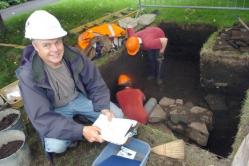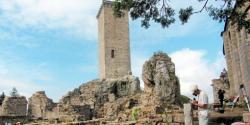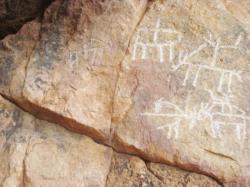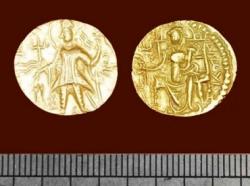- 27 - 28 AOÛT
- INDI-UNI : 
PRE-INSCRIPTION : 15 Juin – 31 Août
PRE-REGISTRATION: June 15th - August 31st
- CANADA –  Québec - Les vestiges du premier rempart de Québec viennent d'être déterrés sous ce qui deviendra un terrain de jeu pour les jeunes écoliers du monastère des Ursulines de Québec. L'emplacement des tranchées creusées dans le verger a été tracé comme on marque une carte au trésor d'une croix. On cherchait l'enceinte de terre battue qui traversait la propriété religieuse et qui encerclait la ville. Les archéologues ont plutôt dépoussiéré un bloc de maçonnerie et des trous indiquant l'emplacement de pieux. «Il pourrait s'agir d'une réparation au rempart original, suppose M. Rouleau au sujet du bloc, mais certainement d'une partie de la palissade», assure-t-il. Les pierres de remblai qu'on observe également aux alentours proviennent selon lui de «l'effleurement du sol» lorsqu'on a déplacé la terre pour donner forme au rempart. «L'axe des trous des pieux est extrêmement important» à titre d'indice sur l'orientation de l'enceinte, poursuit-il. Les six pouces de diamètre que mesurent les trous correspondent à l'image documentée de la façade. L'enceinte de Beaucours, cons-truite en 1693, rappelle la mémoire du signataire des plans, l'officier Boisberthelot de Beaucours. L'ouvrage de maçonnerie déterré confirme donc l'existence de la fortification qui parcourait la falaise de Québec, en passant par la Citadelle, par le parc du Cavalier-du-Moulin, et qui complétait sa boucle au parc de l'Artillerie. Le long de ce tracé, des fouilles avaient déjà permis de révéler des vestiges de la porte Saint-Jean, de la redoute à l'extrémité nord du rempart, ainsi que des pieux indiquant que d'anciennes fortifications ont déjà descendu jusqu'à la rivière Saint-Charles. Le choix de repousser en 1745 l'emplacement du rempart actuel, tel que Chaussegros de Léry l'a conçu, répondait aux besoins d'expansion de Québec dont la population était jusqu'alors massée en basse ville. On croit que des soldats ont foulé la première fortification jusqu'aux environs de 1712 et qu'elle a pu «disparaître» vers 1720. «On en perd la trace» à cette date, explique M. Rouleau.
Québec - Les vestiges du premier rempart de Québec viennent d'être déterrés sous ce qui deviendra un terrain de jeu pour les jeunes écoliers du monastère des Ursulines de Québec. L'emplacement des tranchées creusées dans le verger a été tracé comme on marque une carte au trésor d'une croix. On cherchait l'enceinte de terre battue qui traversait la propriété religieuse et qui encerclait la ville. Les archéologues ont plutôt dépoussiéré un bloc de maçonnerie et des trous indiquant l'emplacement de pieux. «Il pourrait s'agir d'une réparation au rempart original, suppose M. Rouleau au sujet du bloc, mais certainement d'une partie de la palissade», assure-t-il. Les pierres de remblai qu'on observe également aux alentours proviennent selon lui de «l'effleurement du sol» lorsqu'on a déplacé la terre pour donner forme au rempart. «L'axe des trous des pieux est extrêmement important» à titre d'indice sur l'orientation de l'enceinte, poursuit-il. Les six pouces de diamètre que mesurent les trous correspondent à l'image documentée de la façade. L'enceinte de Beaucours, cons-truite en 1693, rappelle la mémoire du signataire des plans, l'officier Boisberthelot de Beaucours. L'ouvrage de maçonnerie déterré confirme donc l'existence de la fortification qui parcourait la falaise de Québec, en passant par la Citadelle, par le parc du Cavalier-du-Moulin, et qui complétait sa boucle au parc de l'Artillerie. Le long de ce tracé, des fouilles avaient déjà permis de révéler des vestiges de la porte Saint-Jean, de la redoute à l'extrémité nord du rempart, ainsi que des pieux indiquant que d'anciennes fortifications ont déjà descendu jusqu'à la rivière Saint-Charles. Le choix de repousser en 1745 l'emplacement du rempart actuel, tel que Chaussegros de Léry l'a conçu, répondait aux besoins d'expansion de Québec dont la population était jusqu'alors massée en basse ville. On croit que des soldats ont foulé la première fortification jusqu'aux environs de 1712 et qu'elle a pu «disparaître» vers 1720. «On en perd la trace» à cette date, explique M. Rouleau.
http://www.cyberpresse.ca/le-soleil/actualites/la-capitale/201108/27/01-4429501-le-premier-rempart-de-quebec-exhume.php
- FRANCE –  Apcher - L’activité est retombée sur le site du château d’Apcher en cette deuxième quinzaine d’août. La douzième campagne de fouilles archéologiques s’est achevée avec le départ des archéologues. En douze ans, le site est passé d’un contexte d’éboulis envahis par l’herbe et les arbustes à un château certes détruit mais où apparaissent murailles, pièces et bâtiments divers interprétés par l’archéologue grâce aux architectures différentes selon les époques. Tessons de poterie, tommettes, verres, ossements d’animaux, objets de la vie courante comme dés à jouer, aiguilles, dés à coudre, boucles de ceinture, pièces, carreaux d’arbalète, pointe de hallebarde, éperon, planchers et carrelages, tous ces objets sont collectés, classés et répertoriés, puis sont étudiés par des spécialistes qui les reconstituent et les interprètent de manière rigoureuse et scientifique. Cela permet de dater l’occupation et la construction du site. C’est ainsi que l’on retrouve la vie quotidienne des constructeurs et des occupants du château au cours des siècles. Les fouilles sont effectuées par progression verticale, couche par couche, et ce jusqu’au substrat naturel : terre ou roche. On recule ainsi dans le temps au fur et à mesure que l’on descend. Une fois la campagne achevée, le chantier est interdit au public car les murs sont fragiles et dangereux, les sols ne sont pas stabilisés. La campagne 2011 a permis de dégager les derniers espaces au nord des bâtiments près de la chapelle, ce qui a obligé à détourner le chemin par l’arrière de celle-ci. Le puits situé dans la cour intérieure a été fouillé par un spécialiste, et, comme on s’y attendait, a livré des objets (seaux en bois, chaîne, écuelles…) tombés au fond de ses 14 mètres, taillés en grande partie dans la roche dure (leucogranite). Après douze années de travaux, le corps du château est pratiquement dégagé sauf dans sa partie ouest correspondant à l’entrée, et qui s’avère complexe. Ce sera probablement le but de la prochaine campagne. Une référence Avec la chapelle restaurée, le donjon également et aménagé pour permettre un accès jusqu’à son sommet, le château des fiers barons d’Apcher sera à moyen terme le site de référence dans le département. Le château principal des barons d’Apcher est implanté à partir du XIe siècle sur un promontoire occupé depuis fort longtemps. L’étymologie du nom en atteste, Apchier est un nom gaulois composé de “ap” : endroit fortifié, et “chier”, chaos rocheux. On ne sait comment de petits seigneurs locaux en arrivèrent à de telles possessions. La baronnie d’Apcher occupait le nord du comté du Gévaudan. Ces puissants barons contrôlaient un territoire de plusieurs dizaine de km2, allant de la rivière Bès jusqu’à la Truyère, de la Rimeize jusqu’aux sommets de la Margeride. Longtemps, ils ont été propriétaires de la moitié de la terre de Randon.
Apcher - L’activité est retombée sur le site du château d’Apcher en cette deuxième quinzaine d’août. La douzième campagne de fouilles archéologiques s’est achevée avec le départ des archéologues. En douze ans, le site est passé d’un contexte d’éboulis envahis par l’herbe et les arbustes à un château certes détruit mais où apparaissent murailles, pièces et bâtiments divers interprétés par l’archéologue grâce aux architectures différentes selon les époques. Tessons de poterie, tommettes, verres, ossements d’animaux, objets de la vie courante comme dés à jouer, aiguilles, dés à coudre, boucles de ceinture, pièces, carreaux d’arbalète, pointe de hallebarde, éperon, planchers et carrelages, tous ces objets sont collectés, classés et répertoriés, puis sont étudiés par des spécialistes qui les reconstituent et les interprètent de manière rigoureuse et scientifique. Cela permet de dater l’occupation et la construction du site. C’est ainsi que l’on retrouve la vie quotidienne des constructeurs et des occupants du château au cours des siècles. Les fouilles sont effectuées par progression verticale, couche par couche, et ce jusqu’au substrat naturel : terre ou roche. On recule ainsi dans le temps au fur et à mesure que l’on descend. Une fois la campagne achevée, le chantier est interdit au public car les murs sont fragiles et dangereux, les sols ne sont pas stabilisés. La campagne 2011 a permis de dégager les derniers espaces au nord des bâtiments près de la chapelle, ce qui a obligé à détourner le chemin par l’arrière de celle-ci. Le puits situé dans la cour intérieure a été fouillé par un spécialiste, et, comme on s’y attendait, a livré des objets (seaux en bois, chaîne, écuelles…) tombés au fond de ses 14 mètres, taillés en grande partie dans la roche dure (leucogranite). Après douze années de travaux, le corps du château est pratiquement dégagé sauf dans sa partie ouest correspondant à l’entrée, et qui s’avère complexe. Ce sera probablement le but de la prochaine campagne. Une référence Avec la chapelle restaurée, le donjon également et aménagé pour permettre un accès jusqu’à son sommet, le château des fiers barons d’Apcher sera à moyen terme le site de référence dans le département. Le château principal des barons d’Apcher est implanté à partir du XIe siècle sur un promontoire occupé depuis fort longtemps. L’étymologie du nom en atteste, Apchier est un nom gaulois composé de “ap” : endroit fortifié, et “chier”, chaos rocheux. On ne sait comment de petits seigneurs locaux en arrivèrent à de telles possessions. La baronnie d’Apcher occupait le nord du comté du Gévaudan. Ces puissants barons contrôlaient un territoire de plusieurs dizaine de km2, allant de la rivière Bès jusqu’à la Truyère, de la Rimeize jusqu’aux sommets de la Margeride. Longtemps, ils ont été propriétaires de la moitié de la terre de Randon.
http://www.midilibre.fr/2011/08/27/les-secrets-du-site-d-apcher-le-chateau-siege-de-puissants-barons-a-ete-construit-au-xie-siecle,378006.php
- INDE – 
 Kirana Hills - Rock carvings and relics were discovered at Kirana Hills in Northwest Chiniot recently. The region is popularly known as Punj Peer. Archaeology Department officials said that after examining the base of the rock platform and the cleft in part of the hill, they were of the opinion that these were the walls of a stupa. Kirana stone, terracotta bricks, pottery, animal bones and human remains have so far been found over nine acres of land. Umar Daraz, the Lok Baithak convener, said that a gold coin was discovered by the group from one of the eight mounds. He refused to specify the location but said the site had to undergo further excavation. Markings on the coin, which also depicts a goddess feeding a child, have aided archaeologists in determining that the coin is from the Kushana period. It has been compared with other coins of the period on display at the Lahore and Taxilla Museums, said Afzal Khan, the Deputy Director of Archaeology Department. No photographs of the rock carvings Kirana Hills, discovered in 1995, have been published so far, according to Khan. Fine, intricate carvings showing men on horses and in combat are speculated date back to the time when Alexander the Great invaded the region, he said. The latest carvings, he said, are as recent as 300 years ago. Three overlapping circles abundantly carved on Kirana indicate that inhabitants of these hills were Buddhists, Khan said. Other patterns observed are of hands, chess board, ships and flowers. Some historians are of the view that the site may hold the lost OJAN or OJAIAN, a Buddhist university contemporary with the Julian University in Taxilla – the only two Buddhist universities from that time, Khan said.
Kirana Hills - Rock carvings and relics were discovered at Kirana Hills in Northwest Chiniot recently. The region is popularly known as Punj Peer. Archaeology Department officials said that after examining the base of the rock platform and the cleft in part of the hill, they were of the opinion that these were the walls of a stupa. Kirana stone, terracotta bricks, pottery, animal bones and human remains have so far been found over nine acres of land. Umar Daraz, the Lok Baithak convener, said that a gold coin was discovered by the group from one of the eight mounds. He refused to specify the location but said the site had to undergo further excavation. Markings on the coin, which also depicts a goddess feeding a child, have aided archaeologists in determining that the coin is from the Kushana period. It has been compared with other coins of the period on display at the Lahore and Taxilla Museums, said Afzal Khan, the Deputy Director of Archaeology Department. No photographs of the rock carvings Kirana Hills, discovered in 1995, have been published so far, according to Khan. Fine, intricate carvings showing men on horses and in combat are speculated date back to the time when Alexander the Great invaded the region, he said. The latest carvings, he said, are as recent as 300 years ago. Three overlapping circles abundantly carved on Kirana indicate that inhabitants of these hills were Buddhists, Khan said. Other patterns observed are of hands, chess board, ships and flowers. Some historians are of the view that the site may hold the lost OJAN or OJAIAN, a Buddhist university contemporary with the Julian University in Taxilla – the only two Buddhist universities from that time, Khan said.
http://tribune.com.pk/story/240797/excavation-findings-carvings-reveal-kirana-hills-buddhist-heritage/
- USA –  Thunder Bay - What is it? "Essentially, it's a national park out in the water that is dedicated to protecting the Great Lakes and their rich history," said superintendent Jeff Gray, 39, a Livonia native and Dearborn Divine Child graduate who has degrees in maritime history and underwater archaeology. The sanctuary, designated in 2000, covers 448 square miles of Lake Huron off the northeast Lower Peninsula, an area known as shipwreck alley in the heyday of Great Lakes shipping because of its fog and dangerous shallows. About 200 shipwrecks have been identified in and around the sanctuary, which Gray says may be only half the actual number on the lake bottom in the area.
Thunder Bay - What is it? "Essentially, it's a national park out in the water that is dedicated to protecting the Great Lakes and their rich history," said superintendent Jeff Gray, 39, a Livonia native and Dearborn Divine Child graduate who has degrees in maritime history and underwater archaeology. The sanctuary, designated in 2000, covers 448 square miles of Lake Huron off the northeast Lower Peninsula, an area known as shipwreck alley in the heyday of Great Lakes shipping because of its fog and dangerous shallows. About 200 shipwrecks have been identified in and around the sanctuary, which Gray says may be only half the actual number on the lake bottom in the area.
http://www.freep.com/article/20110828/NEWS06/108280462/You-haven-t-lived-here-until-You-visited-Thunder-Bay-National-Marine-Sanctuary
- BULGARIE – Saint Ivan Island - The new archaeological excavations on the island of Saint Ivan close to the seaside town of Sozopol are successful, Tsonya Drazheva, deputy head of the excavations, said. she said that the team’s priority this year was to unearth the remaining part of the earliest Christian church where the relics said to be those of John the Baptist were discovered in 2010. "We have started examining the narthex of the church. As you might know, in early Christianity churches were very big and there were no closed areas," Drazheva was quoted as saying. This narthex, or anteroom, was designed for those who were not familiar with Christianity, she said. Drazheva said that important elements had been unearthed that were related to liturgical practices of the beginning of the fifth century CE. In the building of a church named after John the Baptist, walls a metre and a half thick had been found below the foundations of the church of an ancient building dating back to the third century BCE. "Perhaps it was not a church, but a commercial building possibly related with the busy local port," she said. The archaeologists have studied 25m of an ancient wall, which surrounded the highest area on the island. While carrying out excavations, the archaeologists discovered many interesting finds, such as ceramics, glass and many other items related with a rich monastery. Excavation work on the island this year started at end of July and finish on September 3.
http://www.sofiaecho.com/2011/08/28/1145974_archaeology-excavations-on-bulgarias-st-ivan-island-a-success-report